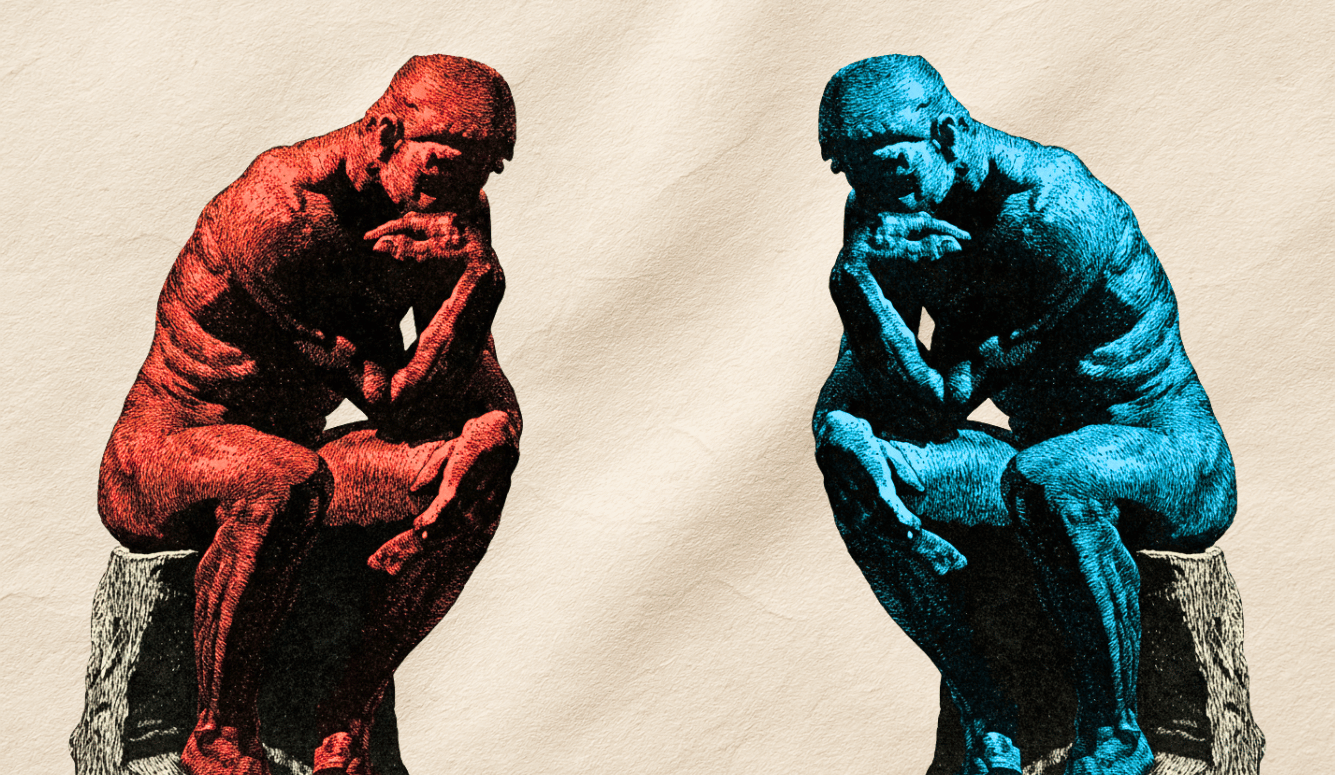Politics
The Heterofatalism Trap
Essays about contemporary dating are mistaking cruelty for liberation.

On a summer evening in downtown Manhattan, four professional women gather at a vegan restaurant to perform a ritual as old as consciousness itself: the airing of romantic grievances. “Aww, poor baby!” cries one, a historian, as they mock a man too anxious to show up for sex. The women work themselves “into a frenzy of laughter over men’s inability to ‘man up and [expletive] us,’” and ask in a “smug, chauvinistic” way: “Where were the men who could handle hard stuff? Like leaving the house for sex?”
This scene appears in Jean Garnett’s essay “The Trouble with Wanting Men,” published by the New York Times magazine in July. A week later, Garnett’s piece was followed by Catherine Pearson’s article about “mankeeping” in the same magazine. Both essays represent something more than personal memoir or sociological observation. They capture a peculiar moment in contemporary gender discourse, and together, they constitute documents of a cultural transformation. The language of female liberation has become a vehicle for new forms of domination, and feminist vocabulary is used to police intimacy, not expand human possibility.
What’s needed isn’t another framework for understanding gender relations but the courage to abandon these frameworks altogether—to meet each other as individuals rather than representatives of abstract categories and to risk genuine encounters rather than performing a reactive pseudo-sophisticated critique that only aggravates existing discord. The pathology evident in these articles runs deeper than individual expressions of romantic disappointment. It exemplifies what Friedrich Nietzsche warned would happen when liberation movements arise from ressentiment rather than creative force: upon gaining power, he predicted, the oppressed reproduce the very structures they once claimed to oppose, but with the added viciousness of retribution. What Nietzsche identified—and what the Times articles inadvertently demonstrate—is the transformation of fear-based subordination into resentment-based aggression. The mockery and generally unsympathetic attitudes on display in the essays illustrate what happens when fear curdles into contempt rather than dissolving into genuine equality.
Just as the incel movement and various forms of misogyny represent men’s sublimated fear of women—the terror of rejection reconstituted as entitled rage—modern feminist misandry reveals women’s sublimated fear of men transformed into preemptive cruelty. Both dynamics represent abusive responses to vulnerability and both perpetuate cycles of harm, yet social custom currently sanctions one while condemning the other. If gender relations are to improve, neither should be sanctioned.
The Architecture of Heterofatalism
Jean Garnett’s essay introduces us to something called “heterofatalism”—a term coined by sexuality scholar Asa Seresin to describe straight women’s pessimism about dating. The concept promises analytical clarity but delivers an intellectual framework that turns personal responsibility into victimhood. “The complaint is so common,” Garnett explains, “such a cultural and narrative staple, that the academy is weighing in.”
Garnett performs an elaborate dance of self-awareness that never quite arrives at genuine insight. She recognises her own participation in stereotyping (“Men suck. Groundbreaking!”) yet she persists in this way of thinking even so. She moves from specific disappointments to sweeping condemnations of masculine emotional incapacity, and she imposes impossible standards. After a date texts her, “I was really looking forward to seeing you again but I’m going through some intense anxiety today and need to lay low :( ,” she replies: “Totally understand.” But she immediately admits that she didn’t understand. “Feeble, fallible ‘looking forward’ is not longing,” she decrees; “a man should want me urgently or not at all.” The absolutism here—urgent desire or nothing—creates the very dynamics she spends much of the rest of the essay lamenting.
When she and her friends discuss this incident, the therapist among them observes, “That’s life. That’s being alive and going to meet someone you don’t know well.” To which the historian responds, “It’s called ‘sexual tension.’ Stay with it for a minute and you might get some.” But rather than heeding this advice, Garnett retreats into mockery and generalisation, treating her date’s reported anxiety as evidence of some wider masculine failure: “[W]e all cooed and moaned for the poor wittle fraidy-cat boo-boo.” The therapist in the group even offers a pseudo-psychoanalytic explanation about “the anxiety of needing to ‘justify the phallus,’” and asks “from the child’s point of view, it’s like, ‘I get what Mom is for, but what are you for? What’s the point of your thing?’” This leads to the women “miming confrontations with imaginary members—‘Who invited you?’ ‘What’s your deal?’ ‘Are you lost?’”
What’s particularly striking is how Garnett presents this casual disdain. She doesn’t frame the scene as a shameful moment of weakness or a regrettable instance of poor behaviour. Instead, it reads as a kind of consciousness-raising session, a moment of feminist bonding that we are expected to find amusing and perhaps even empowering. “[L]ately I have been bruised by the ambivalence of men,” Garnett reflects, “how they can first want me and then become confused about what they want, and this bawdy, diminishing humor soothed me, made me feel more powerful, more in control.” What we are witnessing is the transformation of legitimate grievances into licence for emotional cruelty. This represents a profound betrayal of feminism’s promise of liberation. Rather than expanding possibilities for human connection beyond patriarchal constraints, this approach instead adopts them.
Elsewhere in the essay, Garnett admits that she “couldn’t desire” a transparent and communicative partner she calls “Sex Nerd,” who offered her exactly what she says she wants: respectful desire and emotional availability. His eager reassurances—“If you feel our energies aren’t matched, I won’t argue,” and “No pressure”—represent the apotheosis of contemporary progressive masculinity. Yet Garnett finds herself unmoved and even repulsed: “If only I could desire a man like that, a man bringing such clear terms to the table, enough to be disappointed by him.”
Garnett elaborates on this man’s philosophy with barely concealed scorn: “Many dabblers in nonmonogamy were not really, he noted with a laugh, quoting the rapper Pusha T, ‘’bout dat life.’ He was.” When he asks about her feelings regarding group sex and she expresses no interest, he tells her that is “totally valid.” His repeated assurances that her desires are “valid” become, in her telling, evidence of something suspect rather than the respectful communication she claims to want.
So, Garnett mocks men for being anxious and emotionally remote, yet when presented with a confident, communicative man, she finds him equally if not more off-putting. This suggests that the problem lies, not in male behaviour but in something deeper—perhaps in desire itself, or in the frameworks through which she interprets her experiences. In their own ways, both the anxious man and the excessively agreeable “Sex Nerd” represent different responses to the same cultural confusion. Neither represents the kind of creative and self-possessed masculinity that might transcend these dynamics. Even if such masculinity did manifest—imperfect as any human expression must be—it would likely face comparable scorn from these writers, much as creative and self-possessed women face predictable derision from the worst corners of male internet culture.
This admission exposes the bad faith at the heart of Garnett’s essay. The problem isn’t male inadequacy but her attraction to ambivalence, which the essay refuses to interrogate seriously. She keeps returning to the same thought—“There must be something wrong. I keep thinking, with the way I desire”—yet never pursues what lies beneath this surface recognition, forgoing discernment for a mere performance of self-awareness.
The Commodification of Care
Catherine Pearson’s article on “mankeeping” elaborates this analytical failure in a different way. The term, coined by postdoctoral fellow Angelica Puzio Ferrara, describes “the work women do to meet the social and emotional needs of the men in their lives, from supporting their partners through daily challenges and inner turmoil, to encouraging them to meet up with their friends.” As Pearson notes, the concept has “taken off online” and even “taken on a bit of a life of its own, with some articles going so far as to claim that mankeeping has ‘ruined’ dating and driven women to celibacy.”
The “mankeeping” article has various problems, but at least it is a lot less pathological than Garnett’s piece. The dynamic it describes—one partner bearing disproportionate responsibility for social planning and emotional management—is worth discussing, but it is by no means a uniquely female burden. How many men find themselves responsible for home maintenance, financial planning, or serving as their partner’s sole source of emotional stability? How many men navigate their partner’s social anxieties, manage her family relationships, or find themselves cast as therapist, life coach, and security blanket rolled into one? The universality of these dynamics suggests we’re not dealing with patriarchal exploitation but with the ordinary difficulties of intimate partnership.
The article’s central example is Eve Tilley-Colson, a 37-year-old attorney who “finds herself offering [her boyfriend] a fair amount of social and emotional scaffolding.” Specifically? She plans their social activities and raises questions about relationship milestones like “When are we going to meet each other’s parents?” and “When are we going to go on our first vacation together?” Tilley-Colson’s complaint illustrates the absurdity of the idea: “They’re both busy attorneys,” Pearson writes, “but she tends to take charge of their social plans. Ms. Tilley-Colson has hung out with her boyfriend’s close friends a handful of times; he hangs out with hers several times a week.” The asymmetry here—that he spends more time with her friends—is somehow evidence of her exploitation rather than his accommodation.
What’s particularly odd about the article is that Pearson presents Tilley-Colson’s relationship as fundamentally happy. Tilley-Colson tells Pearson that her boyfriend of seven months is “emotionally mature, funny and caring” and that the two of them “make a good team.” Yet all this becomes problematic within the “mankeeping” framework, where a loving and functional relationship is recast as a site of gendered exploitation simply because one partner takes more initiative in certain areas.
The “mankeeping” framework transforms every gesture into a ledger entry, and every emotional exchange into a transaction requiring compensation. This framework becomes even more troubling when we consider the dynamics it actually describes. As Pearson notes, “In a 2021 survey, 15 percent of men said they didn’t have any close friends, up from 3 percent in 1990.” This represents a genuine crisis of social connection with serious implications for mental health and wellbeing. Yet rather than approach this crisis in search of collaborative solutions, the “mankeeping” framework transforms women’s support of lonely partners into another source of oppression.

Pearson acknowledges male perspectives but doesn’t properly engage with them. Glenn, Tilley-Colson’s boyfriend, notes that “his gut reaction when his girlfriend first described mankeeping to him was that it seemed consistent with what he’d seen play out in many heterosexual relationships. He wondered, ‘OK, but is that bad?’” This understandable confusion is left unexamined. By recasting ordinary relationship dynamics as gendered labour exploitation, Pearson’s article advocates a kind of transactional and commodified intimacy. She doesn’t consider the possibility that relationships naturally involve different strengths, preferences, and contributions—and that these differences might be complementary rather than exploitative.
The Slave Revolt and the Tiger’s Claw
To understand how a discourse of emancipation becomes a vehicle for domination, we can turn to Nietzsche’s analysis of the “slave revolt in morality.” In the first essay of On the Genealogy of Morals, he writes:
The slave revolt in morality begins when ressentiment itself becomes creative and gives birth to values: the ressentiment of natures that are denied the true reaction, that of deeds, and compensate themselves with an imaginary revenge. While every noble morality develops from a triumphant affirmation of itself, slave morality from the outset says No to what is “outside,” what is “different,” what is “not itself”; and this No is its creative deed.
This perfectly describes the mechanism of “heterofatalism.” Rather than creating new modes of intimacy, it defines itself purely in opposition: not this man, not this behaviour, not this kind of desire. Its creativity extends only to generating new bases for complaint and new reasons for resentment. As Garnett and Seresin both admit, heterofatalism “can produce nothing but more of itself.” The dinner scene in the vegan restaurant shows just how thoroughly ressentiment has poisoned relationship discourse. The women’s mockery exemplifies what Nietzsche meant by slave morality’s reactive nature.
Garnett provides more context about this gathering: “‘When did the men get so anxious about desire?’ asked the therapist, and I said I didn’t know. ‘Yes, you do,’ my friend said. ‘It was when they were put on notice that they can’t just get drunk and grope us.’” In this way, changing standards of male behaviour—a positive development—are made to serve as an explanation for all male anxiety, as if the only way men can confidently pursue women is through intoxication and sexual assault.
But this reductive explanation ignores a more immediate though less obvious source of contemporary male anxiety: the possibility of becoming fodder for exactly the kind of mockery displayed in essays like the one Garnett has just published in the New York Times. When intimate encounters and moments of vulnerability can be used to entertain friends in a Manhattan restaurant or—worse—thousands of strangers who read the Times, is it any wonder that men approach modern dating with trepidation?
Advice that Garnett received from her aunt by text on her way to a date crystallises this dynamic: “Word from an expert. Wait til he wants it so bad he’s nutsy cuckoo. Sounds facile but, man, truer words were never spoken. ‘Make ’em Suffer’ is my mantra!” This isn’t wisdom despite its cruelty but because of it. The ability to inflict suffering becomes proof of power regained and evidence of liberation achieved.
Garnett’s essay represents what Nietzsche called the “tiger’s claw” beneath the glove—feminine power employed within masculine frameworks that proves to be more vicious than traditional male domination:
What inspires respect and, often enough, fear of women is their nature (which is ‘more natural’ than that of men), their truly predatory and cunning agility, their tiger’s claws inside their glove, the naivete of their egoism, their inner wildness and inability to be trained, the incomprehensibility, expanse, and rambling character of their desires and virtues.
While Nietzsche’s language reflects the prejudices of his era, his core insight remains valuable. He identified a form of power that operates through concealment, indirection, and strategic opacity rather than direct confrontation. But Garnett and her cohort have abandoned this natural power for something far less formidable. Instead of the subtle power of the concealed claw, they practise open derision and manipulation.
Both articles reveal a double standard. Male emotional withdrawal is abusive neglect; female emotional withdrawal is sophisticated self-care. Male anxiety is contemptible weakness; female anxiety is a legitimate response to patriarchal threat. Male desire for clarity is controlling; female obfuscation is self-protective. As Garnett says of a guitarist she dated and who once described her as a “bratty sub”:
He did make me wait. I stood at the slot machine watching those cherries and fat yellow coins blur by, and they didn’t stop. He was sweet with me in person, impulsive about biting my nose, but for stretches I wouldn’t hear from him, or I would but only perfunctorily, and then, suddenly, he would pop up. Requesting clarification on what a man feels or wants or sees happening here has gotten me burned before, as it has many women I know. I have learned to regard such demands as “demanding” in a feminized way—simultaneously bossy and supplicating, a reinscribing of the “bratty sub” position. Taking my cues from him, I stayed mostly quiet. Call it “communication pessimism.”
Garnett herself acknowledges this double standard when a former lover critiques her essay draft: “‘You’re flattening the men,’ a former lover wrote to me after I sent him a partial draft of this essay. ‘They never get to be real—they’re used to confirm a story about disappointment and frustration.’” His observation that she might be equally responsible for her own relationship difficulties appears in the essay, but it evidently hasn’t been absorbed by the author.
The Complacency of Complaint
What makes these articles so obnoxious isn’t their individual perspectives but their function as cultural documents. They don’t merely describe a phenomenon; they help to create it. By teaching women to see relationships through the lens of systemic oppression and emotional labour, they encourage a hermeneutics of suspicion that makes intimacy much harder than it needs to be.
This species of feminism displays its bourgeois character through its subjects: lawyers, professionals, people with therapy-speak at their fingertips, and the luxury of theorising their dating lives and performing their disappointments at vegan restaurants in downtown Manhattan. Their complaints—men who are “too anxious” to meet, who need encouragement to see friends and so on—are the problems of a particular class in which traditional gender roles have dissolved but nothing coherent has replaced them.
What’s being protected here is not just romantic complacency but an entire worldview that depends on maintaining clear victim/oppressor dynamics. To acknowledge women’s complicity in confusing dating behaviour, or to recognise their own capacity for emotional unavailability and cruelty, would require these women to surrender the comfortable position of the wronged party. And it is safer to retreat into perpetual disappointment than to risk trying something different.
These educated professionals possess all the analytical tools necessary for self-awareness but they deploy them to achieve precisely the opposite—a cultivated denial of their own role in perpetuating the dynamics making them unhappy. The sophisticated vocabulary becomes a tool of mystification rather than clarification. Every new academic term—“heterofatalism,” “hermeneutic labour,” “normative male alexithymia”—adds another layer of obscurantism separating them from their own desires.
The deepest betrayal lies in how articles like these transform feminist discourse into an elaborate defence mechanism against change. The “liberation” language into which they thoughtlessly lapse serves a specific function: it transforms personal stagnation into political virtue. Can’t form meaningful connections? That’s resistance to patriarchal norms. Consistently attracted to emotionally unavailable men? That’s evidence of masculine inadequacy rather than a pattern worth examining.
As Garnett writes about her failed relationship with a man she calls J.: “I stood there reaching for him while he sad-faced back at me like a boxed mime: He couldn’t talk about it; he wished things were different; maybe someday the child would mature, the glass would break, but for now, there was really nothing to be done.” And yet she chooses men like these and rejects those who offer clarity and availability.
The complacency runs deeper than romantic stasis. These articles represent a broader cultural failure to imagine different ways of life. Rather than asking how we might reconsider intimacy after the collapse of traditional gender roles, they simply document the ruins with sardonic satisfaction. The tone of exhausted knowingness—“men, am I right?”—substitutes for the harder work of building something new.
Garnett herself glimpses this latter possibility when she quotes Jessica Benjamin on breaking the impasse of “complementary twoness”: creating “an ‘intersubjective third,’ a space in which your needs and mine, your desires and mine, recognize and accept each other without competing for dominance.” But she immediately retreats: “I find this distinction difficult to grasp, which is perhaps to say that I experience desire in terms of a struggle that someone must lose.”
Beyond Heterofatalism
Our cultural moment demands more than clever neologisms and pseudo-sophisticated ways of complaining. It requires an approach to dating and intimacy that rejects both patriarchal traditionalism and its feminised inversion. This means recognising that liberation isn’t found in the ability to inflict the wounds once inflicted upon us, but in the capacity to heal them in ourselves and others.
Instead, theoretical frameworks transform love into labour, care into calculation, and desire into resentment. These two articles in America’s newspaper of record are not just isolated perspectives, they are symptoms of a broader cultural trend regarding how we conceptualise all kinds of human connection. When vulnerability is confused with weakness and a desire for connection becomes evidence of exploitation, we haven’t liberated ourselves from oppressive structures, we’ve simply universalised them.
A question haunts both articles: why do contemporary relationships feel so difficult? But this question has an answer that neither author is prepared to accept: because we’ve transformed intimacy into a zero-sum battlefield where showing need is losing and desire itself has become suspect. The frameworks meant to explain our unhappiness have become machines for producing it.
This kind of feminism doesn’t protect women from men, it protects everyone from the possibility that love might demand something more than ironic distance and the abstractions of theory. It might require us to be fools, to risk being hurt, and to look after someone else without calculating what we are owed in return. The answer lies not in academic jargon or therapeutic concepts but in the emotionally hazardous work of actual intimacy.
That we must navigate this minefield so carefully—anticipating defensive responses, preemptively acknowledging legitimate grievances, constantly clarifying that critique of one form of gendered cruelty doesn’t endorse another—itself reveals the depth of our predicament. Perhaps the ultimate irony is that in trying to protect ourselves from being misunderstood, we ensure that genuine understanding becomes impossible.






